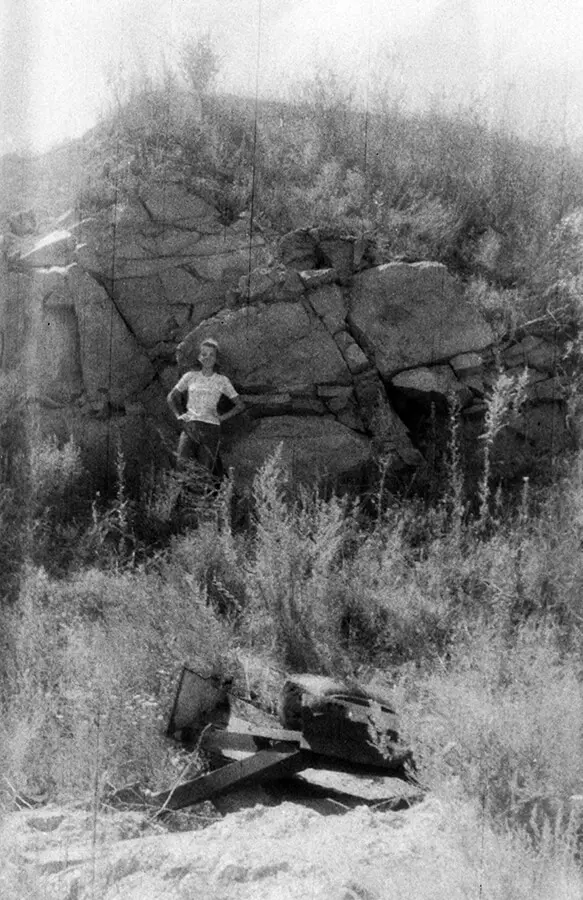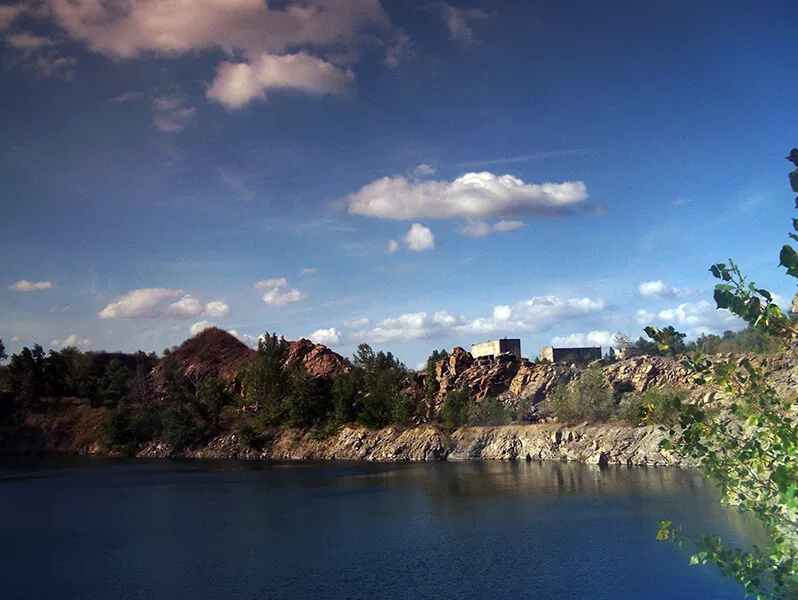
Found photographic film. Taromsky quarry
Abandoned and flooded granite quarry – Dnepropetrovsk region, Ukraine.
This short message is a recollection of my first encounters thirty years ago, and a few refutations of rumors… Some kind of local history trolling 😉Why refutations? Therefore, all these rumors differ from my personal memories. I will also show you some rare Lo-Fi photographs of the Taromsky quarry.
Found photographic film
As a child, I really wanted a camera. The first camera was “Smena 8m” (this is a very cheap and unreliable camera), and taking photographs in the crisis of the 90s was very difficult – it was impossible to get film, photo paper, or reagents, especially for an ordinary teenager. I remember how cheaply I bought half a box of very expired (it is not known in what conditions it was kept) Svema 64 from a friend and was glad about it. I photographed film after film, and put it back in the box, because I couldn’t develop it (I didn’t have anything, and I didn’t know how at that time). So the films accumulated, and some were lost in time and space.
About 15 years ago, in the trash at home, I found some kind of black and white. film, and decided to develop it with what was at hand. I didn’t feel sorry for her because I wasn’t sure that it was my film or that there was anything on it. I found some expired reagents and somehow hastily developed them. As my childhood friend said: “it’s askew and crooked – as long as it’s alive” (Dan, if you’re reading this, greetings and hugs to you).


Imagine my surprise when I saw the image on the negatives and began to recognize landscapes and images familiar from childhood in the frames. Yes – it was my film and these were my memories.
The film depicts our adventures in the then still active Taromsky quarry. I went there with a friend (those were our first industrial-tourist experiences), and then I took my sister there, and we found a place for my father to go fishing.
I felt a little nostalgic and put the film back in the box, along with other videos, and again forgot about those memories for 15 years, because printing low-quality photos was somehow embarrassing…
Taromsky quarry to my memories
Over the past week, several of my friends have been visiting the abandoned Taromsky quarry. The former industrial territory with limited access has become an attractive landscape and tourist site of local importance. Two deep, mysterious lakes and rocky shores attract divers, cyclists, fishermen and picnickers. But I remember this quarry completely differently.
But let me look a little further in time. Even before my personal memories.
In the place where the quarry is now, there once was a path (now Mostovaya Street), along which private estates were located closer to the banks of the Dnieper. Some of the granite rocks here came ashore, so the locals knew about the free building materials and little by little they took stones for their own construction.
To explain how this object developed and fell into decay, I use materials from the site of interactive historical maps of blogger Artem Kostyuk OldMaps.dp.ua
This is what the area where the Taromsky quarry is now located looked like in 1941 https://oldmaps.dp.ua/
This is what the future quarry looked like in 1943 https://oldmaps.dp.ua/


In the 1950s, geological exploration was carried out, the estates were resettled, the path was moved higher up the hill and open-pit mining began to extract granite and gravel for the growing construction needs of two large cities – Dnepropetrovsk and Dneprodzerzhinsk. The demand for material grew, the quarry grew in a north-western direction along the bank of the Dnieper – this is how the second working appeared.
Taromsky quarry in 1970 https://oldmaps.dp.ua/
The country was experiencing a construction boom, the horizons went deeper, and subsequently the pits became lower than the water level of the mighty Dnieper; this was risky because the workings approached the edge of the shore. The miners decided to expand production towards the hill, so in 1970 they began to build a bypass road, and then the path was again moved even higher up the hill.
Taromsky quarry in 1972 https://oldmaps.dp.ua/


In 1974, the old path, which ran close to the quarry, gradually began to be swallowed up by workings. But decades of blasting work make the granite even more cracked, so water begins to appear somewhere at the bottom of the quarry.
There are rumors (“people talk, but people don’t lie” (c)) that the quarry stopped working in 1991 because they reached the springs and the workings were almost immediately swallowed up by water. So I want to refute these rumors!
Firstly, water in any mine workings is commonplace, and such problems have long been solved by collecting water in sumps and pumping out the required number of pumps. Water began to appear in the workings of Taromsky in the late 1960s and early 1970s. Here, for example, is an aerial photograph from 1975. Look closely – you can already see small lakes at the bottom of the workings.
Taromsky quarry in 1975 https://oldmaps.dp.ua/
Secondly, in my personal opinion, the water in this particular quarry is not spring but river, because, as I wrote above, regular blasting operations contributed to the infiltration of the Dnieper waters. Apparently, during these years the need for construction decreased because granite mining temporarily ceased. Therefore, by 1980, both quarry openings were filled with water.
Taromsky quarry in 1980 https://oldmaps.dp.ua/

But there is one “but” here! There were several granite quarries operating near Dnepropetrovsk, and they continued to work, but this one stopped working and was even flooded with water. I have an assumption, which requires verification, that granite was transported from here mainly in the Dneprodzerzhinsk direction.
My readers from the city of Kamenskoye, I ask you to write in the comments whether there were any large construction projects in your city during this period.
I got the impression that some of the users of the OldMaps.dp.ua service are sure that the quarry has been flooded since the 80s, but this is not so. In the mid-90s, I walked with my two feet along the very bottom of the workings. This means that it was flooded and continued to operate at least twice.
Most likely, in the second half of the 80s they decided to continue the work, so the water was pumped out.
What follows are my personal memories.
Taromsky quarry, my memories
I remember the Taromsky quarry like this.
In the 1990s, I spent every summer (and sometimes part of spring and autumn) in Sukhachevka. All these years I have heard warning signals, industrial explosions and all-clear signals. Sometimes there were up to three explosions a day. We were interested – so we went (outside working hours, or weekends – that is, only during safe times) to look at what was happening there.
At the bottom (bottom) of the quarry, drilling rigs and large excavators worked; near each working (there were two), crushing complexes and screens worked, which distributed the crushed stone into fractions. KrAZ 256 dump trucks were constantly driving towards the rumbles, which were filled with gravel, and they took it away somewhere.


The workings were divided into horizons, like terraces. As we walked along the horizons, we came across stones with holes from wells through which explosives were placed, or stones with marks drawn by geologists. In some places there was a chain of concrete shelters, where they hid from the debris of explosive equipment during work. Near the rocks and especially at the base of the quarry it was very hot and stuffy even in the evening, because the granite stones heated up in the sun and gave off the accumulated heat for a long time.
On the south-eastern side there were small administrative buildings and farmsteads with workshops for mechanics who serviced tractors and excavators. There is still a concrete pier near the shore on which a portal crane worked, loading dumps on a barge with a grab bucket. But I never saw him work. The pier was deep, so we went there to fish for gobies.



Opposite the pier on the left bank there was a reserve with a “bird market” of river birds (gulls, terns, ducks, storks and herons), so that during the day the bird violence could be heard very loudly even across the river bed. But even here there were plenty of birds – sometimes partridges, frightened by someone, rose from the tall grasses near outbuildings. A little further downstream, near the shore, there was a half-sunken barge aground.


From the hill above the quarry there was a view of the Dnieper and the Orilsky Nature Reserve (opposite, on the left bank). We walked up that hill at night – at this time a fantastic landscape opened up to us, like in the paintings of Arkhip Kuindzhi “Ukrainian Night”, but to the moonlight reflected from the river, distant industrial silhouettes and lights of the DMZ were added.
This is exactly how I remember this place.


When did work end?
Although some people claim that the last year of operation of the Taromsky quarry was 1991, the quarry worked until the mid-1990s, one of my acquaintances, an explosion specialist, confirmed to me. Then came the crisis of the 90s, large construction projects stopped throughout the country, the need for large volumes of granite disappeared, so gradually everything here began to fall into disrepair, was destroyed, plundered. The pumps were turned off and the water gradually filled the workings, absorbing horizon after horizon until the level reached the river waters.
This is how the former industrial area turned into an amazing landscape formation.
In 2010, I returned here with an expensive modern camera. But that is another story…






